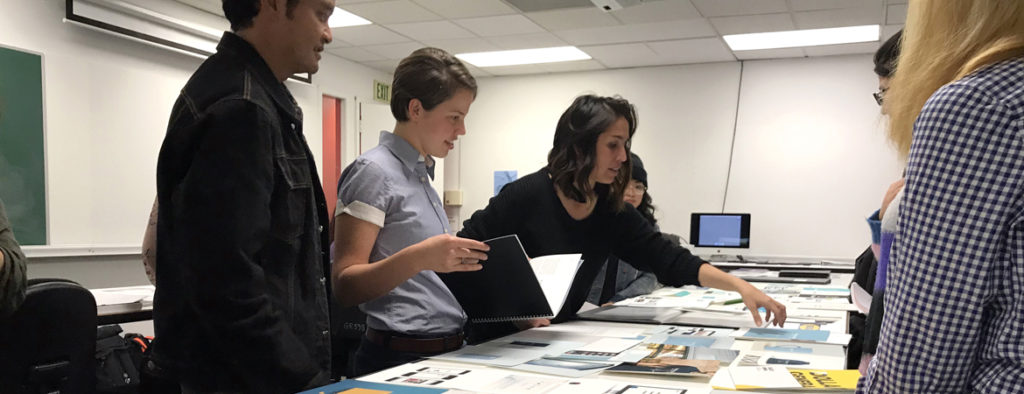There are a few reasons I love being an adjunct instructor in the Graphic Design Department at the Academy of Art University in San Francisco. But which one is my biggest inspiration?
Is it because I enjoy mentoring and coaching? Absolutely.
Do I love the creative vibe in the city of San Francisco? You bet.
Maybe because it’s my alma mater? Yeah, for sure.
Or is it because I like extending my Thursday workday to 12 hours? That’s a big NO (but I suck it up for the main reason listed next).
Maybe it’s because I have the opportunity to recruit top students for entry-level employment? DING-DING-DING!
Makes sense, right? Think about how advantageous it is to get 15 weeks to make a non-pressured decision on hiring your next designer. 15 weeks can provide some amazing clarity on student’s approach, work ethic, and general attitude. The problem is, students don’t realize that these are the qualities I am looking at the most. From my perspective, they are essential in a semester-long interview.
Since my teaching began in 2009, I’ve homed in on key student attributes that I find more powerful, valuable, and unfortunately rarer each semester. But when I see it, you can guarantee we will be discussing your career plans at the semester’s end. And that is what I’d like to share with you now.
6 things students can do that impress me more than pure design chops.
#1 Learn small talk.
Talk to me. Say, “Hi, how is your day going?” I mean, I’m not a big, scary beast (I don’t think so, anyway) and I just came from work, which means I’m pretty sure I have a relevant nugget of agency life to share. Why small talk? There are moments with clients that require conversation to flow. In the elevator, walking to the conference room, etc. This is the beginning of building relationships with clients. It’s also important to show them your personality.
#2 Tell me a story.
It may not be on the New York Times Bestseller list, but still you have a story you want (and need) to tell when you are presenting your concepts and design solutions in class. Believe in your story, even if it is totally whack. I’m looking for effort here. I sucked at it when I was in school but learned the skill over time. Explain what your design is inspired by. What metaphor is in play, and what does it represent? Explain your mood board with meaning. Get detailed and rationalize it. A good story goes a long way. Did I also mention that I typically invite colleagues to critique your final presentation? (Check out that photo of Allen, Laura and Fio) So, there’s a good chance you’ll tell your story to complete strangers, who are also evaluating your job potential. It’s good character building for you.
#3 Be present.
Yes, physically present. No, really. You are spending a lot of money to get your design degree. Be punctual. My biggest pet peeve. Show up before the instructor. During your critique, contribute in the discussion, take notes and doodle sketches and ask questions. Facial expressions other than “deer in headlights” go a long way too—and are encouraged.
#4 Show patience.
From my experience working with young designers, I have concluded that their biggest self-inflicted barrier is to embrace patience. In a world of instant gratification and responses from social media, apps, and devices, sometimes you need to embrace the process, patience, and rigor needed to get to the best solution. I gravitate to the journey of design much more than the destination. When I review your process book of chicken-scratch to final computer renderings, it had better convey this to me: “I tried every imaginable idea I could think of.”
#5 Prove me wrong.
My design team does it constantly. Many times, they are right, and I’m OK with that. I say it all the time—It’s not the “Andrew Show.” Yes, I ultimately have the final say in the classroom, but I expect you to show diligence when you challenge direction by (1) doing what I’m asking, THEN (2) doing your additional solution—letting the best solution prevail.
#6 Be memorable.
How do you do that? Do the previous 5 things I mentioned, and you’ll be there, top of my mind. I get asked several times a year by other colleagues, “I need a good designer right out of school—know anyone?” You’d be surprised how small the design community is, so if you can make yourself memorable, that is a huge advantage. My mental checklist of attributes I can’t teach goes like this (in order of priority first):
- Did you have a good attitude?
- Did you put the effort in?
- Did you show up to class and on time?
- Did I enjoy your critique and discussion?
- What was your energy level like?
- Did you have a sense of humor?
- Did you connect with me LinkedIn as I encouraged? (It’s a good offer, because I can be their biggest advocate.)
Did you notice that “be a superstar designer” is not on the list? That’s because skill development can be taught. Plus, when you surround yourself with other strong creatives, your design chops are going to improve on their own. But the other attributes are part of who you really are—something more important than what you learn in school. And a designer who demonstrates these qualities is someone I want to work with. I can’t emphasize it enough.
And for you seasoned design professionals, get involved with teaching! It’s one of the most gratifying experiences I’ve had.
